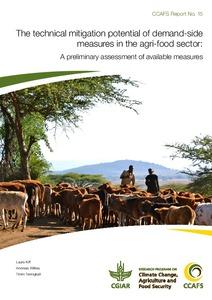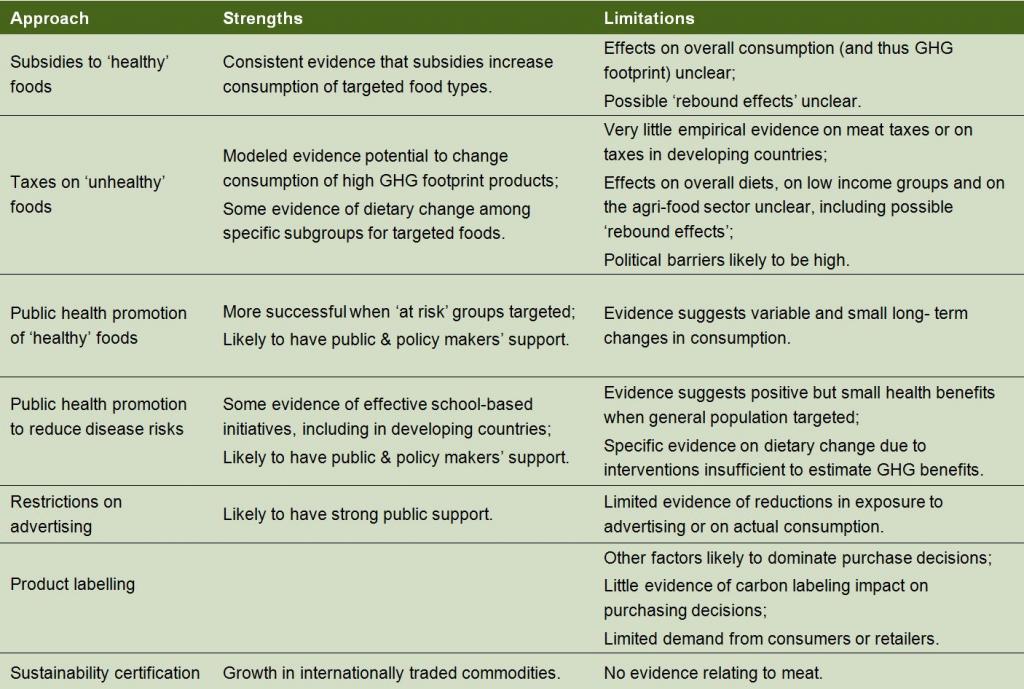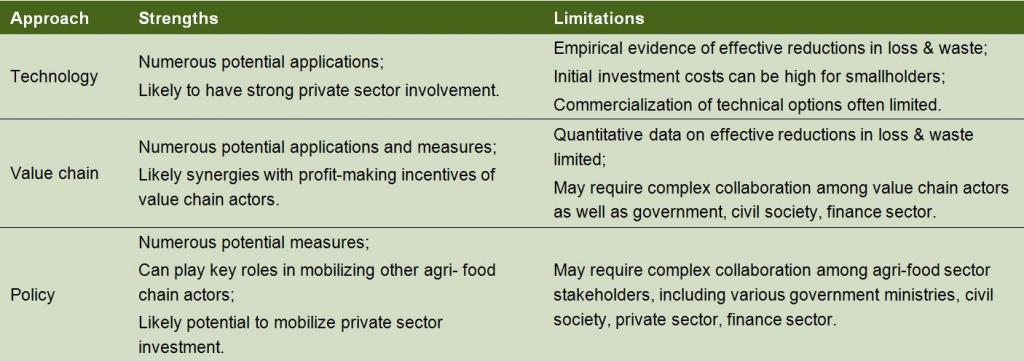Changing our food consumption patterns is necessary to slow climate change, but is large-scale change feasible?

A preliminary assessment of available demand-side mitigation measures finds that certain health and nutrition, and food loss and waste-reduction measures can reduce greenhouse gas emissions.
Limiting climate change to 2oC requires reduced greenhouse gas emissions from both supply-side agriculture (production) and demand-side agriculture (including food’s path from farm gate to consumer plate, consumer choices, and food loss and waste). Discussions of climate change mitigation in the agriculture sector have tended to focus on technical and policy options for changing production rather than consumption, but recent literature has found the technical mitigation potential of demand-side changes to be quite high. However, evidence on the feasibility and effectiveness of demand-side measures, particularly in developing countries, is very limited.
A recent report and accompanying info note by CCAFS and UNIQUE Forestry and Land Use examined whether demand-side policies and measures can support food security and effectively mitigate greenhouse gas emissions in developing countries, with foci on dietary changes and reducing food loss and waste.
Evidence of feasibility to influence dietary choice
Researchers investigated how hard policies – subsidies and taxes that affect price – and soft approaches – such as health promotion, product labeling, and certification – influence consumer diets. Though research shows that price, taste, convenience and habit are the most important determinants of consumers’ purchases, the study found that packages of policy mechanisms and interventions involving health, nutrition, efficiency and sustainability were more successful in achieving dietary change than any one measure.

Health, nutrition, efficiency and sustainability influence families' food choices across the world, including this family in the Philippines. Photo: IRRI
Most dietary change measures have been implemented by governments in the developed world to address the health effects of consumption of unhealthy foods. However, developing countries are increasingly focusing on healthy diets. Several countries in Latin America are conducting health promotion campaigns to reduce diet-related non-communicable diseases, such as obesity. Mitigation will be a co-benefit of these campaigns,” explained Andreas Wilkes of UNIQUE Forestry and Land Use.
The table below shows a qualitative summary of strengths and limitations of potential demand-side policies and measures that could achieve public health objectives and mitigate greenhouse gas emissions.
Source: Kiff et al. 2016
Multiple benefits from decreased consumption of livestock products
FAO projects that population growth and nutrition transition will lead to global increases in meat and milk production by 73% and 58%, respectively, by 2050, most rapidly in Africa and Asia. Increased consumption of livestock products, combined with less physical activity associated with urbanization, is expected to increase rates of cardiovascular diseases and diabetes, particularly in low and lower middle income countries.
Researchers suggested that shifting consumption away from livestock products is a major opportunity for reducing greenhouse gas emissions and may also provide health, food security and other environmental benefits, thought this is context-specific. How much mitigation can be accomplished remains unclear. Research quantifying potential greenhouse gas emissions reductions due to decreased livestock consumption has only been published for Europe, where potential reductions are estimated at 7-36%.
See also the recent discussion of vegetarianism featuring Andy Jarvis or the article analyzing ten dietary scenarios in the U.S.
Evidence of feasibility of reducing food loss and waste
There are many existing technologies and processes to reduce food loss and waste, but governments, producers and private sector actors along the value chain will need to work together to achieve significant reductions, said Wilkes.
Adoption rates of technical, technological and infrastructure options that reduce food loss and waste are generally low, often because they have not been developed in a way that is commercially viable. Authors recommend a bottom-up identification of food loss and waste reduction priorities in product value chains with high greenhouse gas footprints and implementation through the private sector. Private sector investment in reducing food loss and waste, they found, requires an enabling environment, commercially viable investments, and increased awareness among financial institutions. Food loss is a bigger issue in the developing world than consumer waste.
The table below provides a qualitative summary of strengths and limitations of approaches to reduce food loss and waste follows.
Source: Kiff et al. 2016
Closing the evidence gap
Participatory research is needed to provide the evidence base for building and reporting on sustainable consumption systems, particularly in developing countries, where there is a larger evidence gap. Authors identified the following key areas for research. These CCAFS reports provide a start.
As a result of these gaps in evidence, the authors identified the following key areas for future research:
- Quantify demand-side GHG mitigation potential based on what is economically and socially feasible.
- Identify the conditions enabling synergies in policy approaches with other sectors.
- Identify emissions hotspots in specific value chains and analyze how to best engage with related value-chain actors.
- Analyze conditions needed to encourage more private sector investment in reducing food loss and waste and related emissions.
Further reading:
- Kiff L, Wilkes A, Tennigkeit T. 2016. The technical mitigation potential of demand-side measures in the agri-food sector: a preliminary assessment of available measures. CCAFS Report No. 15.
- Wilkes A, Kiff L, Wollenberg E. White J. 2016. Shifting food consumption to mitigate climate change is critical to fulfilling the Paris Agreement, but how? CCAFS Info Note.
Julianna White is program manager for low emissions agriculture research at CCAFS.



